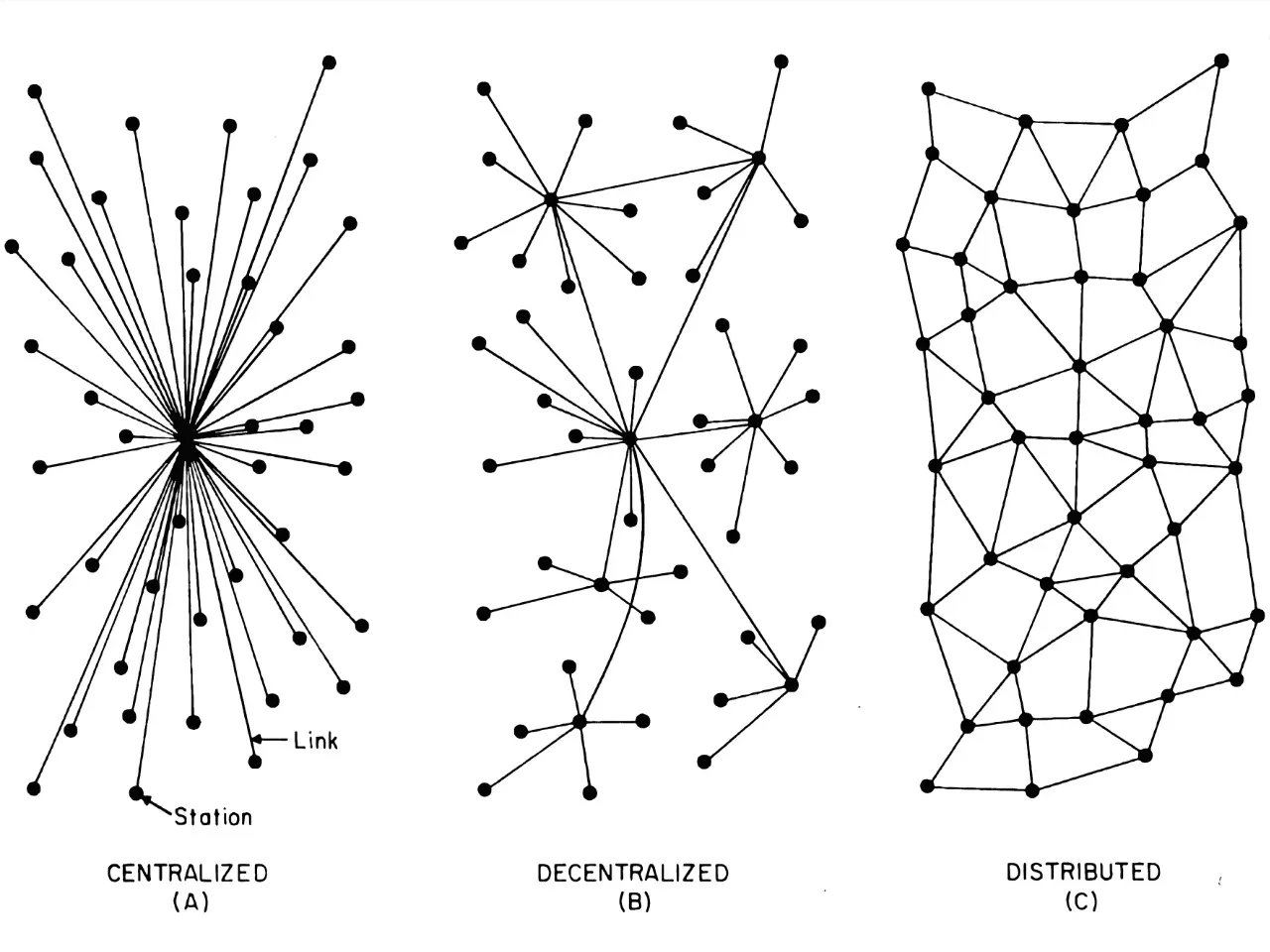Distributed vs. Decentralized Networks: Understanding Key Differences in Modern Contexts
Over the years, the terms “distributed” and “decentralized” have been used interchangeably, often leading to confusion. Both concepts are foundational in understanding modern network structures, from the internet to blockchain technology. This article aims to clarify the differences and update the conversation with contemporary examples and applications. To begin, we revisit Paul Baran’s pioneering work in the 1960s at the RAND Corporation. Baran’s groundbreaking paper, “On Distributed Communications,” introduced the fundamental structures of centralized, decentralized, and distributed networks. Let’s dive into these concepts and their relevance today.
Centralized Networks
A centralized network resembles a star topology where all nodes connect to a central hub. This hub serves as the single point of control and communication.
Characteristics:
- Single Point of Failure: If the central hub fails, the entire network collapses.
- Efficiency: Centralized networks are efficient for small-scale systems where control and management are essential.
Examples:
- Early Bulletin Board Systems (BBS)
- Traditional corporate IT infrastructures with centralized servers
While centralized networks are simple and efficient, their vulnerability to failure led researchers to explore more robust alternatives.
Decentralized Networks
In a decentralized network, no single node holds absolute control. Instead, authority and connectivity are distributed among multiple nodes.
Characteristics:
- Fault Tolerance: Removing a few nodes or connections doesn’t disrupt the entire network.
- Partial Redundancy: Nodes often have multiple links, ensuring communication remains possible even during localized failures.
Examples:
- The Internet (in its early architecture): ISPs and backbone providers interconnect to create a decentralized topology.
- Blockchain Networks: Systems like Bitcoin and Ethereum leverage decentralized architectures to ensure reliability and security.
A good rule of thumb to distinguish decentralization is this: if removing a central node doesn’t segment the network into isolated parts, the network is decentralized.
Distributed Networks
A distributed network takes decentralization a step further. Every node connects to multiple others and can act as both a client and server.
Characteristics:
- High Redundancy: Most nodes have numerous connections, making the network almost impervious to disruption.
- Equal Responsibility: Nodes share the responsibility of forwarding traffic and maintaining the network.
Examples:
- Peer-to-Peer (P2P) Systems: File-sharing networks like BitTorrent exemplify distributed architectures.
- Content Delivery Networks (CDNs): Platforms like Akamai or Cloudflare distribute content across multiple servers to ensure availability and speed.
Distributed networks prioritize reliability. Even if a large number of nodes or links are destroyed, the network remains operational.
Decentralized vs. Distributed: Key Differences
While both terms are related, they differ in scope and implementation:
- Connectivity:
- Decentralized networks may have nodes with limited connections.
- Distributed networks aim for extensive interconnectivity, often resembling a complete graph.
- Responsibility:
- In decentralized networks, specific nodes may still hold greater authority.
- In distributed networks, all nodes perform similar functions.
- Practicality:
- Decentralized networks are more feasible for large-scale systems.
- Distributed networks often face scalability and efficiency challenges.
Modern Applications and Trends
Centralized Systems in 2024
Centralized systems remain prevalent, especially in scenarios where control and security are paramount. For instance, cloud service providers like Amazon Web Services (AWS) or Google Cloud operate centralized infrastructures with robust failover mechanisms.
Decentralized Networks in Emerging Technologies
Decentralization has become a cornerstone of Web3 technologies. Decentralized Autonomous Organizations (DAOs) and decentralized finance (DeFi) platforms rely heavily on this model to distribute governance and reduce reliance on central authorities.
Distributed Networks in Critical Infrastructure
Distributed systems are increasingly essential in modern applications:
- Blockchain: Technologies like Solana and Polkadot adopt distributed consensus mechanisms for scalability and security.
- Edge Computing: IoT devices connected in distributed networks process data closer to the source, reducing latency and improving efficiency.
Paul Baran’s Influence Revisited
Paul Baran’s diagrams of centralized, decentralized, and distributed networks remain a touchstone for understanding network structures. His vision has shaped the design of resilient communication systems that underpin today’s digital landscape.

Conclusion
Understanding the differences between centralized, decentralized, and distributed networks is crucial in a world increasingly reliant on digital infrastructure. While centralized systems offer simplicity and control, decentralized and distributed networks provide resilience, scalability, and innovation. As technology evolves, hybrid architectures combining the strengths of these models are likely to dominate.
References:
- Baran, Paul. “On Distributed Communications: I. Introduction to Distributed Communications Networks.” RAND Corporation, Read here.
- Nakamoto, Satoshi. “Bitcoin: A Peer-to-Peer Electronic Cash System,” 2008.
- Recent advancements in edge computing, blockchain, and content delivery networks.